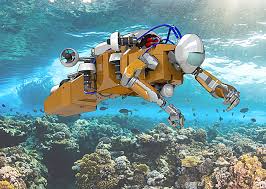
The oceans cover more than 70% of Earth’s surface, yet over 80% of them remain unexplored. The depths are dark, cold, and under immense pressure—conditions that make human exploration extremely difficult and dangerous. Enter robots: unmanned machines that are now transforming our understanding of the deep sea, revealing mysteries that were once thought unreachable.
1. Why Ocean Exploration Is Challenging
Humans face multiple obstacles in deep-sea exploration:
- Extreme Pressure: At depths of 10,000 meters, the pressure is over 1,000 times greater than at sea level.
- Darkness: Sunlight doesn’t penetrate the deep ocean, requiring artificial lighting.
- Harsh Conditions: Cold temperatures and unpredictable currents make it hazardous for divers.
- Scale: The sheer size of the ocean makes full exploration impossible without advanced technology.
These challenges have driven scientists to rely on robotic explorers to probe the depths safely and efficiently.
2. Types of Ocean Robots
Several kinds of robots are used for ocean exploration:
- Remotely Operated Vehicles (ROVs): Controlled from ships, equipped with cameras, arms, and sensors to collect samples.
- Autonomous Underwater Vehicles (AUVs): Pre-programmed robots that navigate and map the ocean independently.
- Gliders: Lightweight, energy-efficient robots that drift with currents while collecting data over long distances.
- Hybrid Vehicles: Combine remote control and autonomous capabilities for complex missions.
3. What Robots Have Discovered
Robotic explorers have made incredible discoveries, including:
- New species: Bioluminescent fish, deep-sea corals, and previously unknown microorganisms.
- Shipwrecks and historical artifacts: Preserving human history in ocean depths.
- Hydrothermal vents: Studying ecosystems that survive without sunlight.
- Pollution mapping: Identifying microplastics and chemical contamination in remote regions.
Without robots, many of these discoveries would have been impossible.
4. Why Robots Are Better Than Humans in the Deep Sea
- Safety: Robots can withstand pressures and temperatures lethal to humans.
- Endurance: Machines can operate continuously for days or weeks.
- Precision: Equipped with advanced sensors, they can measure minute chemical or physical changes.
- Cost Efficiency: Robots reduce the need for expensive manned expeditions.
5. The Future of Robotic Ocean Exploration
The next generation of ocean robots promises to be even more advanced:
- Swarm robotics: Groups of small robots working together to map large areas quickly.
- AI integration: Machines that can make decisions in real time based on environmental data.
- Energy harvesting: Robots powered by ocean currents, reducing the need for frequent recharging.
- Deep-sea labs: Autonomous stations where robots collect and analyze data continuously.
These innovations could eventually allow humans to explore the ocean in unprecedented detail, uncovering new species, ecosystems, and resources.
Final Thoughts
Robots are not just tools—they are our eyes and hands in places humans cannot reach. By extending our reach into the deep ocean, robotic explorers are helping us understand the planet, protect its fragile ecosystems, and reveal secrets that have remained hidden for millions of years.